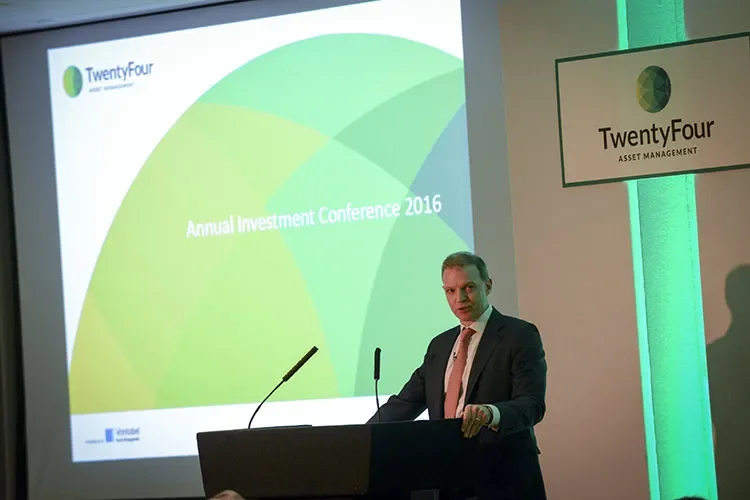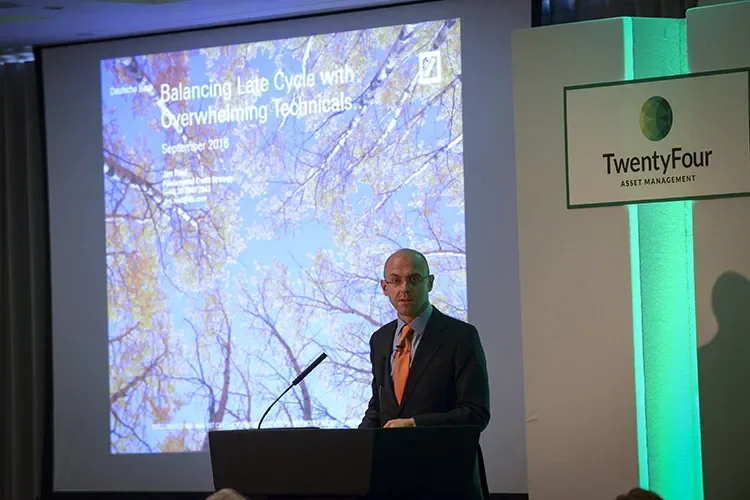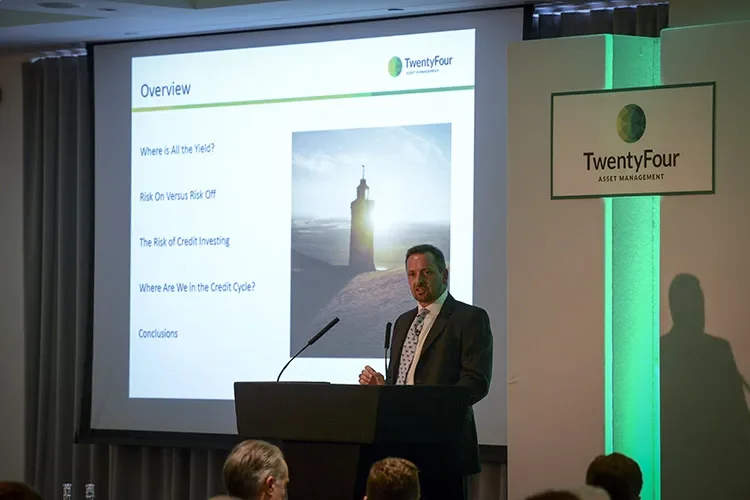TwentyFour Annual Fixed Income Investment Conference 2016
Fixed Income Conference - 15th September 2016

The three hour conference provided over 200 of our clients a unique insight and outlook into Fixed Income markets, with Jim Reid (Chief Strategist at Deutsche Bank) as a keynote speaker.
Agenda
1.00pm Registration
1.45pm Graeme Anderson, Chairman (TwentyFour Asset Management) Chairman's Opening Remarks
2.00pm Jim Reid, Chief Strategist (Deutsche Bank, Author of ‘Early Morning Reid’) 'Balancing Late Cycle with Overwhelming Technicals?'
2.45pm Mark Holman, CEO (TwentyFour Asset Management) 'TwentyFour’s Views on the Market and The Current Risks and Opportunities in Fixed Income'
3.30pm Meet the Managers – 2x break-out sessions
The conference was then followed by a drink and canapés reception.

Chairman's Opening Remarks

- TwentyFour entered into a strategic partnership with Vontobel last year who acquired a 60% shareholding in the Firm. We continue to enjoy positive synergies from this relationship and have started efforts with global distribution.
- AUM has increased to £7bn (up from £5bn this time last year)
- Launched a number of funds in 2015 (Corporate Bond Fund, UKML, Absolute Return Credit Fund and Global Unconstrained Bond Fund). These have performed well and continue to grow
- Move to a new office later this year, which will provide a platform for further future growth
- Also establishing a permanent footprint in the US
- Have undergone a corporate branding refresh
- Continue to invest in the best talent through our hiring

Balancing Late Cycle with Overwhelming Technicals

Jim Reid, Chief Strategist, Deutsche Bank
- We are in very unusual markets; very strong technical support but we are starting to see the signs of late cycle behaviour. How long will this carry on? Could we see a Japan type scenario?
- UK base rates are at their lowest since the BoE formed in 1694 – recent historic average of c. 2% compared with 0.25% now
- Netherlands 10yr Government Bond yield is at the lowest point for over 500 years
- Central Bank balance sheets are at the highest levels and continue to be supportive – could we see helicopter money?
- European credit benefiting hugely from recent Central Bank policy and fundamentals are good. Fed balance sheet has jumped from a historic average of $500bn to over $4,500 in 2015
- However, US credit fundamentals are deteriorating – showing signs of late cycle behaviour
- European Bank equities also showing late cycle behaviour
- Current economic era has been characterised by globalisation and a huge change in the world’s demographics – “35 year super cycle”. This has helped dictate asset performance
- Conclusion: Not the best environment for equities, but credit should continue to perform

TwentyFour's views on the market and the current risks and opportunities in Fixed Income

Mark Holman, CEO, TwentyFour Asset Management
Where is All the Yield?
- Multiverse Index shows a market cap of 50 trillion, with a duration of 7 years and a yield of just 1.49% - no a great risk / reward
- Not much yield in rate products – EUR government bonds yield just 0.22% (including the periphery). Still some yield in UST
- Can still achieve yield in credit; £ HY and $ HY look attractive on a relative basis
- Negative yield is a bubble
- Biggest investors in EUR HY are European IG managers – shows the portfolio effect of QE
Risk On Versus Risk Off
- Negative correlation assets no longer yield anything
- Hence, investors are forced down the credit spectrum in search for yield
- Central bank intervention and QE policies takes time, but show long term strong technicals
- In the fullness of time, credit should always outperform
The Risk of Credit Investing
- Credit spreads are positively correlated with equity markets
- Biggest risk is default – as well as liquidity in the market place
- Mark to market volatility can present opportunities
- The US shows late cycle behaviour – signals include corporate leveraging, downgrades, tightening of financial conditions and shocks to the system
- Central banks contribute to the end of the cycle: all recessions and hard landings have been preceded by a tightening of financial conditions
- Central banks control the risk free rate, commercial banks control the credit rate. Useful to follow the commercial bank credit conditions survey
Where Are We in the Credit Cycle?
- UK and Europe show easing of standards, US shows modest tightening in certain sectors – late cycle behaviour
- Rating migrations year to date show Europe has 3:1 upgrades to downgrades
- Spreads in US, UK and Europe all highly correlated and have seen a degree of spread tightening in 2016, although still wider than January 2015
- Tightening can occur, but a catalyst in the form of an asset price crash is needed for a recession
- Spreads can stay low for a long time e.g. 1945 – 1965 in US and the current environment in Japan
Conclusion
- Yield will remain a scarce commodity in rates and credit
- Credit markets will outperform over the medium term but be wary of the cycle, especially in the US
- Safe play is European credit, followed by UK
- No value in ultra-low rates
- Flexible mandates help take advantage of the opportunities in credit

Break-Out Sessions
- Unconstrained Fixed Income & Asset Backed Securities
- Outcome Driven & Unconstrained Fixed Income
- Asset Backed Securities & Outcome Driven
Unconstrained Fixed Income
This session provided the chance to meet the ‘Unconstrained’ team with Eoin Walsh and Gary Kirk giving an insight into the unconstrained strategies, including the Dynamic Bond, Global Unconstrained Bond and Select Monthly Income funds. Picking up from the market views earlier in the conference, the team looked at how these themes are expressed within the unconstrained portfolios and explained the dynamics of the team.
Asset Backed Securities
This session provided the chance to hear from the ABS team, with Ben Hayward and Rob Ford looking at the relative value across the ABS universe verses traditional corporate bonds and high yield bonds.They then looked at how this relates to the opportunities within three investment vehicles that they manage; Senior Secured Bond Fund, Monument Bond Fund and Twentyfour Income Fund.
Outcome Driven
This session provided the chance to meet the ‘Outcome Driven’ team, with Chris Bowie and Gordon Shannon giving an insight into the two funds that they manage; the TwentyFour Corporate Bond Fund and the TwentyFour Absolute Return Credit Fund. They discussed how constructing portfolios on a risk-adjusted basis leads to less volatility and more predictability of returns, before giving an outlook on Investment Grade credit, given the recent Corporate QE.
